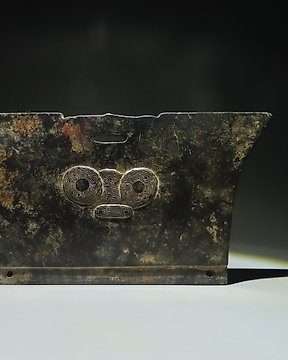
Chinois ancien, Liangzhu Pierre Pendentif ou pectoral rituel. 3500 - 2250 avant JC. 15 cm de longueur.
Nº 84201675

Nº 84201675

Bi - Disc
Ancient Chinese, Liangzhu, 3500 - 2250 BC.
Stone.
18 cm diameter. WITHOUT STAND.
PROVENANCE:
- Private collection, Jacques-André Cronier (1956 - 2019), Mezièrs le Cléry, France.
- By inheritance to its previous owners.
- Art market, France, 2023.
CONDITION: Intact.
From the years 3400-2250 BC, the Liangzhu culture flourished along the Yangtze River Delta in China. Excavations reveal that the culture’s elite was buried alongside jade, silk, lacquer, and ivory objects, indicating a clear divide between the poorest of the period.
Some of the most mysterious and interesting Chinese artifacts produced in this Neolithic period are Chinese bi discs, also called Chinese bi. Typically made using jade and glass, later examples of bi discs date from the Shang (1600-1046 BC), Zhou (1046-256 BC), and Han dynasties (202 BC–220 AD).
What are Chinese bi discs?
Chinese bi discs are flat jade discs with circular holes in the center. In analyzing the bi disc meaning, some historians say it’s a representation of heaven; they’re often found with heaven and earth-like depictions. As a counterpoint symbol, jade congs (straight tubes with circular centers and square outer sections, complete with convex sides), are said to symbolize earth.
According to the Journal of East Asian Archaeology (2000), Chinese bi discs represent the cosmetological concept of “a covering sky that revolves around a central axis, the cycle of Ten Suns, and the use of an early form of the carpenter’s square.” Bi discs were handled by shamans, religious leaders of the Liangzhu society who taught important concepts of cosmetology.
Typically, Neolithic bi discs are not decorated, while those from later periods in Chinese history feature ornate carvings with hexagonal patterns and motifs associated with deities, and the sky and four directions.
As an immense amount of time and effort went into crafting these artifacts, they were found in possession (and in burial sites) of a small concentration of ancient high society.
What were bi discs used for?
So what, exactly, where bi discs used for? While the original function and significance is unknown (hence, their mysteriousness), archaeologists have discovered them buried alongside the deceased upper class, believed to symbolize heaven and the sky, to accompany them in the afterworld. In Neolithic times specifically, they were often placed near the stomach or chest of elite individuals before burial. They were also seen as totems to ward off evil.
In China, the dragon has long been seen as a symbol of power, strength, and good luck—Emperors of Imperial China often wore items with dragon motifs to symbolize his imperial strength and power. Hence, as bi discs were in the hands of—or ceremoniously buried with—the ancient elite, they were often decorated with dragon figures, perhaps in addition to clouds and other sky or heavenly motifs.
Common bi disc materials
Beyond these meaningful motifs, the material of bi discs can also be connected to elite members of ancient societies. Throughout Chinese history, jade has served to represent humans of moral quality, but also one’s rank or class. Jade items like bi discs and guis (bronze Chinese ritual vessels) were often used in ceremonies to honor emperors, kings, dukes, and other noble individuals. Later, during the Zhou dynasty, defeated war leaders gifted victorious leaders of opposition with bi discs to represent submission.
While most commonly and historically made from jade, bi discs can be found in marble, glass, and metal in 20th-century reproductions. Today, their simplicity and roundness, complete with decorative colors, make for lovely objets d’art for interior collections.
Notes:
The seller guarantees that he acquired this piece according to all national and international laws related to the ownership of cultural property. Provenance statement seen by Catawiki.
The piece includes authenticity certificate.
The piece includes Spanish Export License.
Comment acheter sur Catawiki ?
1. Découvrez des objets d’exception
2. Faites la meilleure offre
3. Effectuez un paiement sécurisé